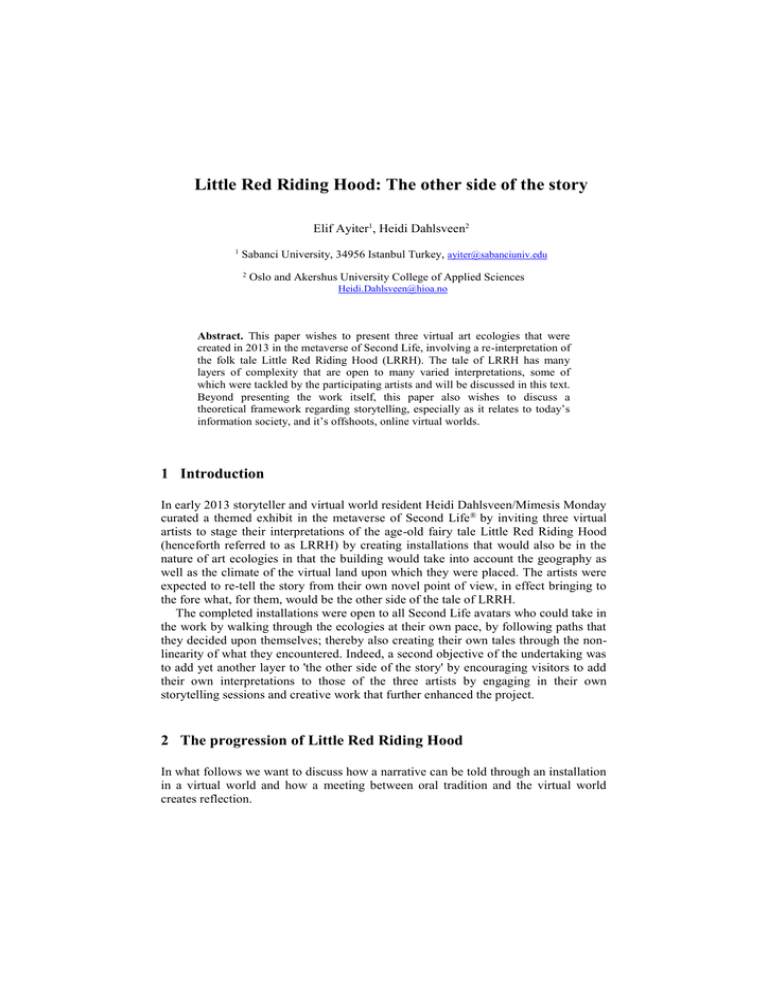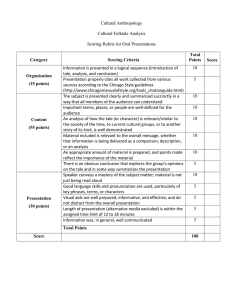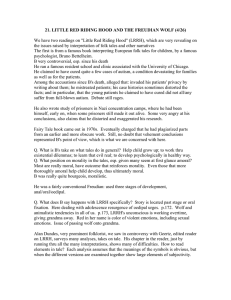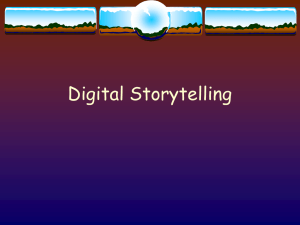Little Red Riding Hood: The other side of the story
advertisement

Little Red Riding Hood: The other side of the story Elif Ayiter1, Heidi Dahlsveen2 1 Sabanci University, 34956 Istanbul Turkey, ayiter@sabanciuniv.edu 2 Oslo and Akershus University College of Applied Sciences Heidi.Dahlsveen@hioa.no Abstract. This paper wishes to present three virtual art ecologies that were created in 2013 in the metaverse of Second Life, involving a re-interpretation of the folk tale Little Red Riding Hood (LRRH). The tale of LRRH has many layers of complexity that are open to many varied interpretations, some of which were tackled by the participating artists and will be discussed in this text. Beyond presenting the work itself, this paper also wishes to discuss a theoretical framework regarding storytelling, especially as it relates to today’s information society, and it’s offshoots, online virtual worlds. 1 Introduction In early 2013 storyteller and virtual world resident Heidi Dahlsveen/Mimesis Monday curated a themed exhibit in the metaverse of Second Life® by inviting three virtual artists to stage their interpretations of the age-old fairy tale Little Red Riding Hood (henceforth referred to as LRRH) by creating installations that would also be in the nature of art ecologies in that the building would take into account the geography as well as the climate of the virtual land upon which they were placed. The artists were expected to re-tell the story from their own novel point of view, in effect bringing to the fore what, for them, would be the other side of the tale of LRRH. The completed installations were open to all Second Life avatars who could take in the work by walking through the ecologies at their own pace, by following paths that they decided upon themselves; thereby also creating their own tales through the nonlinearity of what they encountered. Indeed, a second objective of the undertaking was to add yet another layer to 'the other side of the story' by encouraging visitors to add their own interpretations to those of the three artists by engaging in their own storytelling sessions and creative work that further enhanced the project. 2 The progression of Little Red Riding Hood In what follows we want to discuss how a narrative can be told through an installation in a virtual world and how a meeting between oral tradition and the virtual world creates reflection. There are not too many individuals in western cultures who, as children, did not encounter the tale of LRRH. Some of us remember the story as that of a little girl who was frustrated over not having blonde curls, some of us remember her as a sweet young person who went to visit her ailing grandmother in the forest, while others were traumatized over the killing of the wolf. Indeed the wolf, and the fate that befalls him, is a forceful component of the tale and the encounter between the girl and the wolf are likely to affect us on many levels – some conscious, others sub-conscious. According to Jack Zipes the development of the written story of LRRH is in itself a brutal history in that it is a male creation and projection. Not women, but men – Charles Perrault and the Brothers Grimm – gave birth to our common conception of LRRH as we know the tale today [1]. Zipes points at the existence of an earlier oral narrative in French culture that Perrault very likely based his story about the girl and the wolf upon. Perrault’s great artistic achievement consisted in his appropriating folk motifs, imbuing them with a different ideological content, and stylizing the elements of the plot in such a way that they would be more acceptable to his upper-class audiences, consisting both of children and adults. [2] Thus, it is of no surprise that his literary narrative marks a slow stagnation of the motifs in the story, given that his task was to adapt stories for an aristocratic audience. What is of note is that there are great moral differences between the oral and the literary story developed first by Perrault and later the Brothers Grimm. In the story that we all know as LRRH today, the protagonist is portrayed as a helpless little girl who encounters a dangerous world when she decides to go out alone, refusing to heed the advice of adults. And, unsurprisingly, in the version of the Grimm Brothers, it is an adult male who helps her out of her debacle, when the hunter jumps to her rescue and kills the wolf. Ergo, in the written manifestation of the tale LRRH is depicted as a young woman who is ultimately dependent on men to move on. Indeed the manner in which the wolf is disposed of forms the crux of the difference between the written and the oral versions of tale since in the oral version of the tale LRRH takes matters into her own hands and escapes the wolf through her own devices, with no outside help whatsoever. Therefore, the oral story depicts a strong young woman who is about to become an adult and who through her own efforts and ingenuity can get out of any situation, whereas the written version casts LRRH in a role of dependency due to her gender. That the essence of a tale can have changed and stagnated to this extent due to a specific era's moral considerations, and that it can still be conveyed as a children's story today is disturbing when viewed in this context. 3 The three installations The tale of LRRH has many layers of complexity that are open to many varied interpretations. The three outcomes of the project reflected this diversity: Soror Nishi’s output can be related to a wider concern that addresses the very landscape on which many folk tales are played out – the fantastical setting/flora of the enchanted forest of the tale itself. Cherry Manga and Alpha Auer however chose to take a look at some of the confrontational aspects of the story: While Cherry Manga situated these within the sexual encounters/conflicts that are to be found in the oral version of the tale; Alpha Auer examined a conflict between human and beast, namely humanity’s brutality towards the wolf situated as ‘the other.' Fig. 1. Alpha Auer, Second Life, 2013. (Photograph courtesy of the artist). Alpha Auer's interpretation of the tale placed the wolf at center-stage, as the martyr and LRRH as the human villain who did not baulk at killing creatures that she deemed to be the 'other,' when it suited the advancement of her own interests. Accordingly, the visual elements of Auer's art ecology was dark, dense, confusing and mournful. Fig. 2. Cherry Manga, Second Life, 2013. (Photograph courtesy of the artist). The sequential scenes which Cherry Manga created interpreted the oral tradition of the tale from a novel vantage point. Both Alpha Auer and Cherry Manga utilized three dimensional humanoid or hybrid animal/human models that were meant to provide visual clues to the unfolding of the tale. In Alpha Auer's case these figurines were not placed in such a way that they would provide exit and entry points. There was no clear beginning or ending, instead visitors entered the story at a juncture where it was already at its peak point or even at a point of no return. Consequently it was entirely up to the visitors to construct a story around a central stage that showed an impaled and dying wolf who was being mourned by his family. Further figurines that depicted a number of rather scary LRRHs were scattered around the dark forest in a manner that was meant to accost and unsettle the wandering visitor. Since Auer's story was not a story in the truest sense of word, but instead centered upon the visualization of a general concept of human cruelty to animals, that took its symbolism from the tale of LRRH, this nonlinear setup worked well in her case. Conversely, Cherry Manga’s installation was comprised of four sequential scenes that followed the plot of the French oral tradition in which the young girl initially fools/tricks the wolf through sexual overtures, after which she sleeps with him and then murders him; thus, taking her fate into her own hands. In Manga's installation the three dimensional figurines were used to stage tableaux in which the encounter between girl and wolf, leading to a dance and sexual intercourse were depicted, all of which led to a murder tableaux which symbolized the emancipation of LRRH. Fig. 3. Soror Nishi, Second Life, 2013. (Photograph courtesy of the artist). Rather than delve upon the specifics of the tale Soror Nishi chose to look at the environment, the 'Enchanted Forest,' in which the story unfolded. The third artist, Soror Nishi, followed a distinctive course by focusing not directly on the tale itself, but instead upon the backdrop against which the tale was set. While Alpha Auer, too, devoted much of her building to the creation of a dark and ominous forest in which her story unfolded, Nishi placed the 'Enchanted Forest' at the very center of her artistic investigation, considering the flora of the woods almost as protagonists in their own right. Residing particularly in the realm of Germanic folk traditions, the 'Enchanted Forest' is contradictory in its very essence - both a temple of holiness, as well as the abode of darkness, of evil and of danger. For some thinkers it stood as a model of immortality and regeneration; for others it perfectly illustrated the Darwinian struggle for survival. The forest has formed the context for heroic quests, a place where life had to be wrenched from the dark, foreboding wood with bravery and effort. [3] "It is in the forest that fairy-tale characters often lose their way and then find themselves again as their life’s purpose becomes clear since the fairy tale forest has the power to change hearts and destinies," [4] and "menacing brambles and undergrowth through which the heroes have to pass could symbolize a deep-rooted psychological past that has to be cut through," [5] as is also evidenced in Max Ernst imaginations of the forest from a Dadaist and surrealist perspective, bringing forth paintings such as “Pataphysical Forest,” “Great Forest” and “Last Forest.” Just as Max Ernst did not attempt to paint his forests by depicting biologically correct fauna, Soror Nishi and Alpha Auer also constructed their forests out of plants that were based upon their subconscious imaginings. Nishi says that Virtual Worlds present her with an opportunity to experience a subconscious dream world while conscious. According to Nishi "the computer screen has more in common with stained glass than with photography or film and the extensive attempts some make to populate this new world with 'realistic' copies of the Old World show a colonial tendency to ignore the native culture and superimpose a pre-formed visual style on this new medium. This may be due to a fear of the new, or simply a lack of courage. Hopefully, Time will eradicate this anachronistic tendency."1 4 Constructing Narrative in a Virtual World There is a similarity between the oral tradition of storytelling and a narrative installation in the virtual world, and this resides in the meeting of the story with a preinformed audience who nevertheless fully expected to hear the tale being re-told in a novel and unexpected manner. This is evidenced in the work of Parry and Lord who researched the bards in the former Yugoslavia, looking for clues to the code for understanding the Homeric epics. [6] Through this study they attained an understanding of how the oral tradition of storytelling operated before the written language became dominant. Within this tradition the listeners or community already knew the material that was to be told. Therefore the storyteller’s art consisted of how to compose a story in the here and now, in a novel way, for the current audience. In such a context it appears to be evident that following a linear structure in which events succeed one another will not work. Accordingly, the storyteller does not start at the beginning of the story, but perhaps in the middle, as is also the case in the Homeric epic of "the Iliad," which does not commence at the actual beginning of the event – the divine party on Mount Olympus – but instead starts with the wrath of Achilles, an event that actually happens much later in the epic. Narrative installations in a virtual world appear to work in a similar way in that visitors can wander in and out of the installations without following a linear direction, entering the story from any point of its unfolding, or indeed at a point of no return; as has already been previously discussed. What is equally significant however is that when we enter a narrative virtual world installation, we seem to inevitably enter something that will create an experience which lays the foundations for storytelling and retelling. An excellent example to this 1 Nishi, S. http://andrewsempere.org/ExhibitionSpace/exhibit_soror.cfm phenomenon has been provided by the avatar Saveme Oh who improvised extensively in Cherry Manga's installation of LRRH. Her progression was documented by the avatar Marmaduke Arado, through snapshots that were subsequently published on Oh's blog. When these shots were placed in a specific order which was accompanied by Oh's personal text, it was seen that she had brought forth an entirely new tale which emerged out of the original material that had been provided by Cherry Manga.2 All of this can also be related to Walter Benjamin, according to whom storytelling gives us “the ability to exchange experiences”. [7] In this context it is also noteworthy that Benjamin saw how an excess of information might create poor conditions for storytelling since a story has its basis in sensory involvements and when a story is being told, these are converted into the listener's experience: Every morning brings us the news of the globe, and yet we are poor in noteworthy stories. This is because no event any longer comes to us without already being shot through with explanation. In other words, by now almost nothing that happens benefits storytelling; almost everything benefits information. Actually, it is half the art of storytelling to keep a story free from explanation as one reproduces it. [8] It is precisely due to this dependency on uniquely individual experiences that stories have a long life because this constant regeneration of experience posits that stories are meant to be perpetually retold. Thus, a story can only be based upon experience and not information, since information alone does not provide us with the prerequisites of perpetually rebuilding experience. In the case of LRRH it was things such as the choice of which protagonists to foreground, their depictions and attire, as well as the depiction of the environment in which they were placed, and finally the very non-linearity of the user's actions within this environment, that were expected to build the unique, perpetually re-generated visitor experience. What is also important for a story is its ultimate dependency on a plot, which can also be defined as a deliberate design that helps to make a point with a story. According to Kieran Egan this resides upon a binary concept [9], whereby a story is always developed in relation to a conflict or a tension. The story sorts and structures its content by this tension; a well known circumstance through which binary opposites such as good/evil, greedy/generous, and ugly/beautiful make up the backbones of folk tales. In our project the plot, and its underlying tension of binary opposites, was revealed in the title of the project, through the sentence which proclaimed that what the visitor was about to encounter was 'the other side of the story.' By this foreknowledge the needed tension was created even before a visit to the installations. For Roland Barthes a story is not just a chain of events, but an intricate system of units and rules, consisting of a series of levels that together create meaning. In accordance with these units and rules the story can be divided into three levels: Level of functions, level of actions and level of narration. When it comes to the work discussed it may be beneficial to take a closer look at the level of function, which is the smallest narrative meaning-making unit, the essence of which it is to plant a seed 2 Oh, S. http://savemeoh.wordpress.com/2013/02/20/the-new-little-red-riding-hood-story that is harvested later in the story. Such functions can be divided into two categories: Cardinal functions that are open ended and lead to alternative consequences, in effect making the story a risky place to be; and catalyzer functions that are chronological and logical, and which therefore provide safe and luxurious places to be within the tale. To paraphrase Barthes: "The catalyzer has a constant function which is [that] it maintains the contact between narrator and addressee." [10] Relating these Barthesian definitions to the artwork it can be established that Cherry Manga's approach involves the active usage of catalyzer functions whereas both Alpha Auer's and Soror Nishi's work incorporated cardinal functions: Although the four scenes that Cherry Manga created were placed on the land in a non-linear fashion, nevertheless the very fact that there were four of them and that they narrated progressive parts of the tale made it easy for visitors to follow the plot and the story's development since ultimately there was no room for doubt as to which scene followed which. Alpha Auer's installation, on the other hand, was charged with cardinal functions since the installation featured only one central scene that was the apogee of a series of confusing events. The cardinal feature was emphasized by the fact that it was unclear as to who was the protagonist of the scene: Was it LRRH sneaking away, the mourning wolf family or the sacrificed wolf? Such key questions inevitably left the progression of the plot very much up to the visitor. The same can also be said of Soror Nishi's enchanted forest which presented a dilemma that stemmed from the very absence of protagonists around which a pre-determined sequence of events, or a plot could be constructed; again very much leaving the visitors to their own devices when it came to a satisfactory resolution of the tale. 5 Conclusion One of the wistful charms of virtual output is its transience: The three installations were open to visitors throughout Spring 2013, and were visited by many avatars who took advantage of them to generate their own creative output, based upon what they encountered. In this regard, to judge by the amount of work generated by others, the project has turned out to be a success. In early summer however, the installations were removed, to make place for a novel project of Mimesis Monday's. The three artists and the curator of the project are continuing their creative explorations in the metaverse. Creating narrative environments in virtual worlds remains on the agenda of all of them since this is a subject that begs for much further investigation, both from a practice based, as well as a theoretical standpoint. Indeed the utilization of virtual worlds for storytelling purposes may turn out to be one of the main usages of these environments, given how easily spoken/textual content can be transformed into, as well as supplemented by, visuality and sound within them; potentially emerging as the three dimensional, virtual continuation of the historically well founded tradition of the illustrated non-textual story book. A further, parallel development may also be the provision of a platform that can revive the oral tradition of storytelling based upon experience, further enriched by the visual/audio content that are intrinsic features of these worlds. References 1. Zipes, J., “The Trials & Tribulation of Little Red Riding Hood”. Routledge. New York, (1993): 80 2. Zipes, J., “The Trials & Tribulation of Little Red Riding Hood”. Routledge. New York, (1993): 28 3. Hacken, R., Into the Imagined Forest: A 2000-Year Retrospective of the German Woods, WessWeb, (2008) http://wessweb.info/index.php/Into_the_Imagined_Forest, accessed on 7/9/2013 4. Zipes, Jack. "The Enchanted Forest of the Brothers Grimm: New Modes of Approaching the Grimms' Fairy Tales." Germanic Review 62/2 (1987): 66. 5. Ussher, Arland, and Carl von Metzradt. Enter these Enchanted Woods: An Interpretation of Grimm's Fairy Tales. Dufour, Chester Springs, PA. (1966). 6. Lord, A. "Singer of tales". Harvard University press. London, (2000).:12 7. Benjamin, W. “The Storyteller: Reflections on the Works of Nikolai Levskov, (p.362-378) from Hale D.J.ED.,: “The novel: An Anthology of Criticism and Theory 1900 – 2000. Malden, Mass: Blackwell Publishing. (2006): 362 8. Benjamin, W. “The Storyteller: Reflections on the Works of Nikolai Levskov, (p.362-378) from Hale D.J.ED.,: “The novel: An Anthology of Criticism and Theory 1900 – 2000. Malden, Mass: Blackwell Publishing. (2006): 365 9. Egan,K, “Undervisning som fortelling. Oslo: Ad Notam Gyldendal. (1996) 10. Sontag, S. ED. “A Barthes Reader”. New York: Hill and Wang. (1982): 265


